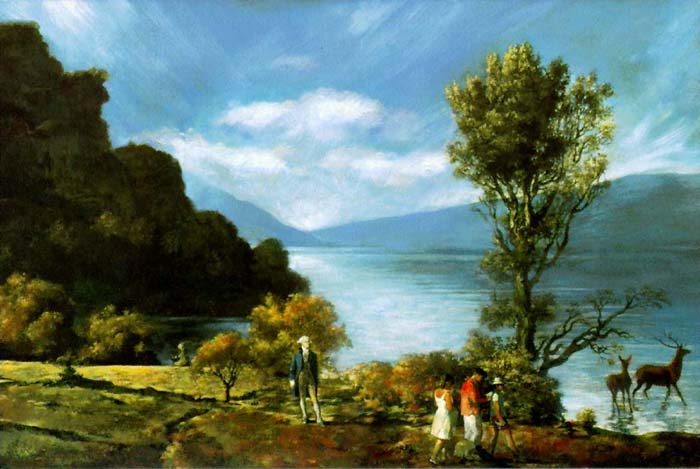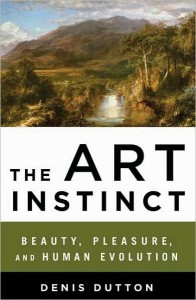
Mr. Scatter apologizes for his recent silence. He’s been a little scattered.
One of the things he’s been doing is reading The Art Instinct: Beauty, Pleasure, and Human Evolution, by Denis Dutton, the philosopher of art who is also founder and editor of the invaluable Web site Arts & Letters Daily.
 The Art Instinct talks a lot about the evolutionary bases of the urge to make art: the biological hard-wiring, if you will. Dutton likes to take his readers back to the Pleistocene era, when the combination of natural selection and the more “designed” selection of socialization, or “human self-domestication,” was creating the ways we still think and feel. To oversimplify grossly, he takes us to that place where short-term survival (the ability to hunt; a prudent fear of snakes) meets long-term survival (the choosing of sexual mates on the basis of desirable personal traits including “intelligence, industriousness, courage, imagination, eloquence”). Somewhere in there, peacock plumage enters into the equation.
The Art Instinct talks a lot about the evolutionary bases of the urge to make art: the biological hard-wiring, if you will. Dutton likes to take his readers back to the Pleistocene era, when the combination of natural selection and the more “designed” selection of socialization, or “human self-domestication,” was creating the ways we still think and feel. To oversimplify grossly, he takes us to that place where short-term survival (the ability to hunt; a prudent fear of snakes) meets long-term survival (the choosing of sexual mates on the basis of desirable personal traits including “intelligence, industriousness, courage, imagination, eloquence”). Somewhere in there, peacock plumage enters into the equation.
There’s a lot to like and a little to argue about in this book, which comes down squarely on the biologically determined as opposed to the culturally determined side of the art-theory fence. Mr. Scatter is an agnostic on this subject, although he leans slightly toward the Darwinian explanation, if for no better reason than that he finds Barthes, Derrida, Foucault and their academic acolytes a bit fatiguing, and he sees no reason why we should consider the analysts of art more important than the artists themselves. Mr. Scatter says this despite his own penchant for analyzing stuff. Besides, The Art Instinct uses a lot of anthropological evidence in support of its argument, and long ago Mr. Scatter was actually awarded (he hesitates to say “earned”) a university degree in sociology and anthropology, although he usually just says “anthro” because that’s the part that seems to have stuck with him in his later adventures in life.
One of Mr. Dutton’s most entertaining passages comes in his first chapter, when he examines the infamous America’s Most Wanted, the 1993 painting by Vitaly Komar and Alexander Melamid. You probably recall it. It’s a sort of “paint-by-survey” artwork, created after polling lots of people on what subject matter they liked most and least in their art. (The Russian expatriates created versions for several nationalities.)
As it turns out, most people want comforting pictures of natural surroundings, and Komar and Melamid’s project, which seems to have purposely wired its survey questions to get specific sorts of answers, makes great sport of that. It was seized upon by experimentalists and academics alike as proof of the cultural cretinism of the common person, who lacks creative imagination and is no doubt a dullard in most other ways, to boot. The most prominent feature of America’s Most Wanted, it could be argued, is the long nose down which it looks.
Dutton proposes another, far more fascinating, way to look at the Most Wanted series of paintings. Never mind how George Washington got at the center of the action: The key is the terrain, which seems like something vaguely out of the Hudson River School. More precisely (or ancestrally), Dutton argues, the ideal human landscape, “what human beings would find intrinsically pleasurable,” is from our common genetic recollection of East Africa. Quoting Gordon H. Orians from his 1992 essay with Judith H. Heerwagen, Evolved Responses to Landscapes, published in the book The Adapted Mind: Evolutionary Psychology and the Generation of Culture, Dutton describes an emotional “home base” landscape of open spaces with low grasses, water either directly in view or nearby, an opening that offers a view of the horizon, animal and bird life, and a lushness of flowers, fruit plants and greenery. In other words: precisely the sort of place that our forebears found fortifiable and capable of providing a good life. A garden, if not precisely Eden.
Is this lowbrow, or unsophisticated, or sentimental? Or is it simply the way we’re wired? Is it, in fact, an extremely sophisticated emotional connection to the defining physical factors of our beginnings as a social species? When Dutton calls it the art “instinct,” he isn’t kidding, although he takes pains to stress that there is no single source, no “art gene,” that can be isolated: It’s a combination of many evolutionary factors, some more direct than others. We are all out of Africa, we are all out of the Pleistocene, and we all have an inbred stake in this thing called art.
Maybe we don’t know much about it, and maybe even our lords of culture know far less about it than they think. But if we can believe Komar and Melamid, at least we all know what we like. It’s in our blood.
*
ILLUSTRATION: “America’s Most Wanted,” by Komar and Melamid.